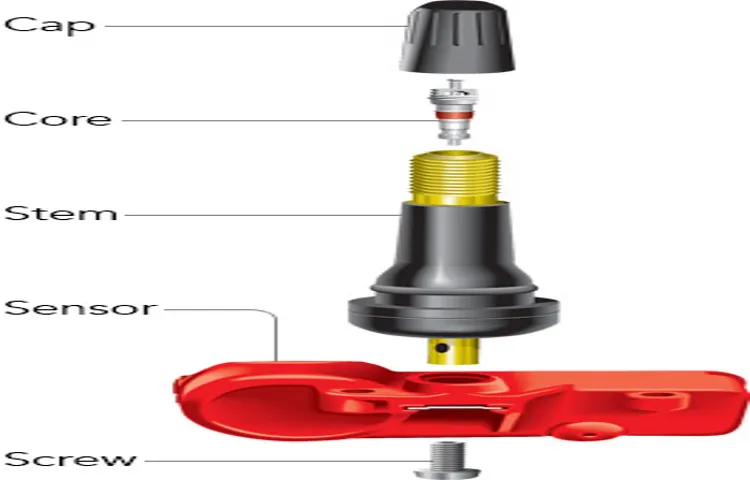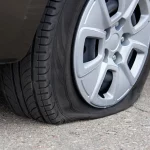Have you ever wondered about those little metal sticks protruding from your car’s tires? You know, the ones that seem to serve no other purpose apart from being there? Well, those little metal objects are called valve stems. They are an integral part of your car’s tire system and play a critical role in ensuring your car runs smoothly and safely. Valve stems are the small devices that keep your tires inflated with the correct amount of air pressure.
They act as the gateway through which air is pumped into your tires and allow you to check the air pressure level using a tire gauge. Without them, it would be impossible to inflate your tires and maintain the necessary air pressure needed for optimal performance. Valve stems come in different sizes and types, depending on the type of car you drive and the kind of tires you use.
They can be made from various materials such as rubber, brass, or aluminum. Each valve stem has a cap that protects it from dust and debris and helps seal moisture out of the tire. In conclusion, valve stems may seem insignificant, but they perform a vital function in keeping your car running smoothly.
The next time you gaze at your tires, spare a thought for these small yet significant devices that keep your vehicle moving safely down the road.
Table of Contents
Definition and Purpose
Have you ever wondered what the valve stem on your tire is all about? Well, it’s the small but important component that helps regulate the air pressure in your tires. The valve stem is a small tube-like structure that connects the tire to the air inflation device. Its purpose is to allow air to be added or removed from the tire, and to keep the tire inflated to the correct pressure.
Without a working valve stem, your tire won’t be able to hold air, causing it to become flat. So, it’s important to make sure your valve stems are intact and functional. Plus, checking your tire’s air pressure regularly will help prevent over-inflation or under-inflation, which can lead to tire damage or decreased performance.
So, next time you look at your tires, remember the valve stem is the unsung hero that keeps you rolling smoothly and safely on the road.
A valve stem is a small component that sticks out through the wheel rim.
A valve stem is a small but crucial component that protrudes through the wheel rim of a vehicle. Its primary purpose is to provide a channel for air to enter and exit the tire. To achieve that function, the valve stem features a core that seals the valve against atmospheric air pressure and prevents the tire from losing air.
Valve stems come in various designs, including rubber snap-in valves, metal clamp-in valves, and high-pressure valves. Each type is designed to fit specific wheel and tire assemblies and has its unique performance features. Valve stems play a crucial role in ensuring a vehicle’s performance and safety.
Without functioning valve stems, tires would lose air pressure, causing the tire to wear unevenly or go flat, leading to impaired handling, low fuel efficiency, and even accidents. Regular inspection and replacement of valve stems help to prevent such issues, ensuring that the tires remain inflated and perform optimally. In conclusion, valve stems seem like small parts of a vehicle, but it’s imperative to check and maintain them regularly to avoid unwanted situations.
It allows air to be added or removed from the tire.
A tire valve is a small but essential component of any vehicle’s tire. It allows air to be added or removed from the tire, providing the perfect balance necessary for optimal performance. The tire valve can be found inside the tire stem and is often made from rubber or metal.
Its purpose is to enable the addition of compressed air or nitrogen gas, which helps maintain the tire’s pressure. The valve also allows for the release of air, which helps control the tire’s inflation in response to varying road conditions. Low tire pressure can cause a tire to wear out quickly or become unstable, leading to a hazardous driving environment.
Therefore, it’s crucial to ensure that the tire valve is well-maintained and in good condition. By keeping your tire valves in top shape, you can avoid low tire pressure, impact absorption issues, and improve your vehicle’s fuel efficiency.
The valve stem also prevents air from escaping the tire.
The valve stem on a tire plays a key role in maintaining proper air pressure. Essentially, it’s the little tube that sticks out from the wheel and allows for inflation or deflation. It’s also what keeps air in the tire, preventing any leakage.
The purpose of the valve stem is to create a seal between the tire and the outside air, and to release air when necessary. This small but essential component is made from durable materials that can withstand the pressure and heat generated from driving. Without an intact valve stem, your tires won’t hold air, leading to low pressure, flats, and even blowouts.
So, the next time you inflate your tires, remember to check the valve stem as well. It may seem insignificant, but it plays a crucial role in keeping you and your vehicle safe on the road.
Types of Valve Stems
A valve stem is the component that allows air to be transferred to and from the tire. It is a small tube-like structure that protrudes from the wheel rim and fits into a hole in the tire. There are different types of valve stems available, with the most common being the Schrader valve and the Presta valve.
The Schrader valve is the most widely used valve stem in tires and can be found on most cars and trucks. It is easy to use and has a spring-loaded valve that opens when air is added and closes when the pump is removed. On the other hand, the Presta valve is commonly used in high-performance bicycles and has a slimmer profile and a threaded cap that needs to be unscrewed to add or release air.
Knowing the type of valve stem on your tire is important when inflating your tires or replacing a faulty valve stem. Whether you have a Schrader or Presta valve, it is important to keep the valve stem clean and free of dirt and debris to ensure proper functionality.
There are two main types of valve stems: snap-in and rubber.
Valve stems are an essential component of any tire, responsible for maintaining proper air pressure. There are two main types of valve stems: snap-in and rubber. Snap-in valve stems are commonly found on passenger cars and are easy to install and remove.
They use a metal clip to hold the stem in place, which can be quickly snapped on and off. Rubber valve stems, on the other hand, are more commonly used on motorcycles and off-road vehicles. They are designed to withstand extreme conditions and can handle higher pressure.
Rubber valve stems are also more flexible, making them better suited for use in vehicles that experience a lot of vibration or movement. When choosing a valve stem, it’s essential to consider the type of vehicle and driving conditions to ensure that you select the right type for your needs. Overall, whether you need a snap-in or rubber valve stem, both are critical for maintaining proper tire pressure and ensuring a safe driving experience on the road.
Snap-in valve stems are commonly found on newer vehicles.
When it comes to valve stems, there are different types you may encounter. Snap-in valve stems are one of the most common types found on newer vehicles. These valve stems have a rubber snap-in base that fits into the hole of the wheel and snaps into place.
They are convenient and easy to install, making them a popular choice among drivers. However, they may not be suitable for high-performance vehicles or those that require higher air pressure. For these types of vehicles, metal valve stems are more appropriate.
No matter what type of valve stem your vehicle uses, it’s important to make sure they are properly maintained and replaced if necessary to ensure proper tire inflation and safe driving.
Rubber valve stems are commonly found on older vehicles.
Valve Stems Valve stems are a crucial component of a vehicle’s tire, responsible for maintaining proper air pressure and allowing for easy inflation or deflation. There are different types of valve stems available, designed to suit different vehicle types and purposes. The most common types include metal valve stems, rubber valve stems, and snap-in valve stems.
Metal valve stems are generally more durable and long-lasting than rubber ones, making them suitable for high-performance vehicles or heavy-duty usage. Rubber valve stems, on the other hand, are commonly found on older vehicles and are more flexible and easier to replace. Snap-in valve stems are the most straightforward type to install and remove, making them ideal for DIY mechanics or temporary tire installations.
Regardless of the type, valve stems are essential for road safety and ensuring optimal tire performance. It is crucial to inspect and maintain valve stems regularly to avoid any mishaps on the road. So, how often do you check your valve stems?
Valve Stem Maintenance
If you’ve ever wondered what the little rubber piece sticking out of your tire is, that’s a valve stem! It’s a basic but crucial component of your tire system, as it’s responsible for holding the air pressure in your tires. Over time, valve stems can wear out or become damaged, leading to leaks or even blowouts while driving. That’s why it’s crucial to regularly check on the condition of your valve stems and replace them if needed.
One way to do this is to inspect them visually for signs of wear, such as cracks or tears. You can also test for leaks by applying soapy water to the valve stem’s base and looking for bubbles, indicating air escaping. Proper valve stem maintenance helps keep you safe on the road and ensures your tires work their best.
Valve stems can leak air, which can lead to tire damage.
Valve stems are an essential component of your vehicle’s tires, but they can be prone to developing leaks over time. When a valve stem leaks, it can allow air to escape from the tire, which can lead to a range of problems, including tire damage and decreased performance. To prevent these issues from occurring, it’s important to perform regular valve stem maintenance.
This can include checking for leaks, replacing worn or damaged stems, and ensuring that the valve cores are properly seated. By taking a proactive approach to valve stem maintenance, you can help ensure that your tires remain in top condition and perform optimally for years to come. Remember, a small investment in maintenance now can save you money and headaches down the road.
Regularly inspecting and maintaining valve stems can prevent issues.
Valve Stem Maintenance Valve stems are an essential component of any valve. These small but mighty parts help control the flow of liquids, gases, and other materials within a system. Even though they may seem insignificant, they play a vital role in maintaining the efficiency of any industrial process.
That’s why it’s imperative to inspect and maintain valve stems regularly. By doing so, you can prevent potential issues like leaks, clogs, or even complete malfunction. Proper maintenance of valve stems includes checking for signs of wear and tear, lubricating the stem, ensuring the alignment of the valve, and tightening any loose connections.
Neglecting to perform these essential tasks can result in costly repairs or even a complete system shutdown. It’s always better to take preventative measures than to wait for a problem to occur. A small investment of time and resources now can save you from bigger problems down the road.
So, the next time you’re performing maintenance on your system, don’t forget about your valve stems!
Conclusion
In summary, a valve stem on a tire is the unsung hero that allows for proper inflation of your wheels. It’s like the little straw in your favorite drink – small, but necessary. Without it, your tire may be flat, your ride bumpy, and your fuel efficiency diminished.
So next time you see a valve stem, give it the appreciation it deserves. Because just like any good relationship, a little maintenance goes a long way.”
Valve stems may be small, but they are essential for proper tire function.
Valve stem maintenance is often overlooked, but it can make a huge difference in the longevity of your tires. Valve stems may seem small and insignificant, but they play a crucial role in maintaining proper tire pressure. It’s important to regularly check your valve stems for damage or wear and tear, as they can develop cracks or leaks over time.
Additionally, it’s crucial to make sure that the valve stem caps are tightly secured to prevent dust and debris from getting inside. A neglected valve stem can lead to decreased fuel efficiency, a rougher ride, and even flat tires. To keep your valve stems in good condition, make sure to check them during routine tire inspections and replace them if needed.
By taking good care of your valve stems, you can help ensure the safe and efficient operation of your vehicle.
FAQs
What is a valve stem on a tire?
A valve stem is a component on a tire that helps control the air pressure in the tire.
Why is a valve stem important on a tire?
A valve stem helps ensure proper tire inflation and can prevent tire damage or failure due to underinflation.
How do I know if my valve stem needs to be replaced?
Signs of a worn or damaged valve stem include air leaks, difficulty inflating the tire, or a visible crack or deformation in the stem.
Can I replace a valve stem myself?
Yes, replacing a valve stem is a relatively simple process that can be done with basic tools and a replacement stem from a tire shop or auto parts store.
Is it necessary to replace the valve stem when installing a new tire?
While it is not always necessary, it is recommended to replace the valve stem when installing new tires to ensure optimal tire performance and prevent future issues.
What are the different types of valve stems available?
Common types of valve stems include snap-in, bolt-in, and clamp-in stems, each with unique features and installation requirements.
How do I choose the right valve stem for my tires?
The recommended valve stem type and size will vary depending on the tire and vehicle specifications. Consult your owner’s manual or a tire professional for guidance.



